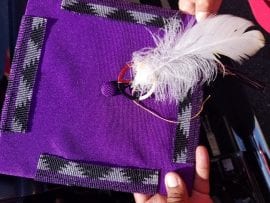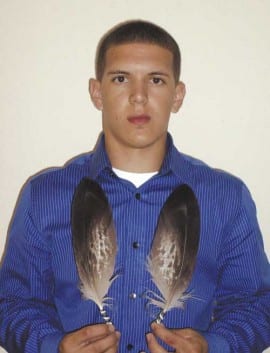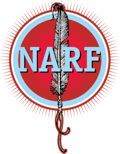Background
In 2019, Larissa Waln (Sisseton Wahpeton Oyate) was turned away from her high school graduation. As she entered the stadium with her classmates, school officials stopped her at the door and would not allow her to enter and participate in the graduation ceremony. The reason? Because Larissa was wearing religious attire, namely a beaded graduation cap including a sacred medicine wheel and eagle plume that had been blessed for the occasion.

The district claimed that allowing Larissa to observe her religion in this way would prove disruptive to other students’ experience of the graduation ceremony and, insisted, that “[n]o student would be allowed to participate in the commencement ceremony with an adorned or altered commencement cap,” with absolutely no exceptions to be tolerated. However, later the same day that Larissa was turned away, another high school in the same district held its graduation ceremony in the same stadium.
At that event, a student wore what appeared to be a breast cancer awareness sticker on his cap. Despite the school district’s pronouncement that no student would be permitted to participate with an adorned cap, this student participated in the ceremony in full view of faculty. Other students all across the district were also permitted to wear all different types of chords and sashes to show their academic achievement.
The Litigation
April 2020: Lawsuit Filed
By refusing to allow Larissa to wear her traditional beaded cap and sacred eagle plume, school and district administrators infringed on the Waln family’s rights to the free exercise of religion, freedom of speech, and equal protection of the law under the Arizona Constitution, the Arizona Free Exercise of Religion Act, the US Constitution, and 42 USC § 1983. On Friday, April 24, 2020, the Waln family, represented by the Native American Rights Fund and Rothstein Donatelli brought suit against the school district for infringing on Waln’s right to freely exercise her religion and her freedom of speech.
The Walns asked the court to declare the policies and practice of banning Native American students from expressing their academic achievement and religious beliefs through beaded caps and eagle feathers or plumes illegal. Native students should not be targeted and forced to choose between their religious and spiritual beliefs and celebrating their academic achievements. Unfortunately, the Arizona district court dismissed the Waln’s complaint in March 2021.
April 2022: New Legislation Passes
Meanwhile, Native American students in the state were also submitting requests to school boards for regalia accommodations at their graduation ceremonies. Facing growing community pressure on this issue, Arizona Governor Doug Ducey signed HB2706 into law on April 20, 2022, making it illegal for Arizona public and charter schools to prevent Native American students from wearing regalia, such as eagle feathers and plumes, at graduation ceremonies.
When she heard about the new law, Larissa was “elated” at how this change would benefit future graduates. Her father Bryan Waln (Rosebud Sioux) also wondered why some educators would prefer court to working cooperatively with students and families on this issue. “It should not have taken legislation to allow Tribal citizens to wear regalia at graduations in Arizona,” said Larissa’s father. “I never thought we’d ever have to protest and bring a lawsuit to protect our rights, but we did.”
July 2022: Ninth Circuit Appeal
Meanwhile, the Waln’s appealed the decision to the 9th Circuit Court of Appeals. Briefs were filed in the case during the first half of 2022 and the case was argued in July 2022.
The appeal proceedings began at 9 a.m. Pacific in San Francisco on July 27, 2022.
On December 9, 2022, the United States Court of Appeals for the Ninth Circuit reversed and remanded the district court’s dismissal of the complaint in Waln v. Dysart School District. The appeals court found that the plaintiffs had shown that the school district’s policy was enforced in a selective manner and had plausibly alleged that there was different “treatment on the basis of viewpoint.” This order directs Larissa’s case back to the U.S. District Court, giving her the opportunity to have her case heard.
NARF hopes that a favorable ruling in court will help Native American graduates nationwide. Each year, educational institutions across the country single out hopeful Native American students like Larissa from participating in their graduation ceremonies due to non-inclusive policies.
“We appealed to the 9th Circuit Court of Appeals because we believe the law should be clear that Native students should not be singled out for different treatment,” said NARF Staff Attorney Matthew L. Campbell. “Many students are allowed to wear their stoles and chords to show their academic achievement, and Native students should be no different.”
“Educators that choose to insist Native American students cannot wear ceremonial regalia like eagle feathers and plumes at graduation perpetuate the sad history of forced assimilation of Native youth,” said Campbell, referring to boarding school policies in the U.S. “You should not have to disavow your religion, your culture, or your traditions to celebrate academic achievement with your classmates.”
April 2023: Settlement After Raising Awareness
On April 18, 2023, Larissa Waln (Sisseton Wahpeton Oyate) and her father Bryan Waln (Rosebud Sioux) announced their agreement to settle their lawsuit against Dysart School District. “My family filed this lawsuit to protect Native peoples’ right to honor our religious beliefs and academic achievement, just as so many other students are permitted to,” said Larissa. “It was an honor to be gifted the eagle plume for my graduation, something I will cherish forever. I hope going forward schools learn to appreciate and respect our tribal practices.”
Bryan had prepared for Larissa’s graduation, including having Larissa’s paternal grandmother bless the plume in a religious ceremony on the Rosebud Sioux Reservation. Because wearing the delicate eagle plume under a covering or hat desecrates the sacred object, Bryan beaded his daughter’s mortar board to attach the plume. When a school official saw the plume and beaded cap, the official prevented Larissa from entering the stadium to participate in her graduation ceremony.
“Public Schools should be lifting up our students and celebrating our Native cultural practices. These items are given in times of great honor and we can think of no better opportunity to give these to our children than when they earn their high school diploma,” said Bryan.
The Ninth Circuit Court of Appeals held that Larissa and Bryan’s federal claims had merit. This was the first time a federal appellate court has ruled on a Native students’ right to wear religious and traditional regalia at graduation. The First Amendments’ free exercise and free speech clause protect our students from being discriminated against. Many states also have laws to protect our students’ right to wear these important items at graduation.
“Dress codes cannot target and alienate Native students, nor require them to sacrifice practicing their spiritual beliefs to celebrate their academic achievements,” said Native American Rights Fund (NARF) Deputy Director Matthew Campbell. “It is unfortunate that in 2023 we are still having to deal with this issue. Modern school policies should celebrate Native traditions, comply with state and federal laws, and aim for inclusive ceremonies.”
NARF and Rothstein Donatelli represented the Walns in the lawsuit, including its successful appeal to the U.S. Ninth Circuit.
The Significance of Eagle Feathers and Regalia at Graduation
Many of the 574 federally-recognized Tribes recognize leadership achievements of individuals by bestowing the person who earned the honor an eagle feather or plume. While tribal religions and spiritual practices vary from each other, in general, a Native person who wears a plume or eagle feather has done something amazing to receive the honor and shows that they have the maturity to pray and care for themselves and others.

Similar to other religious objects, such as a cross or a rosary, Native people have used the eagle feather or plumes to pray. Many tribal religions regard the eagle as the bird that carries human prayers to the creator.
Only a person with the maturity to handle a feather or plume with reverence may use one. Praying with eagle feathers and plumes, and bestowing them as a way to honor a person’s good deed are religious practices that Native peoples have observed for thousands of years.
Like other families across the U.S., Larissa Waln and her family spent her last year of high school excitedly preparing for this major transition in her life. While Larissa would graduate in Arizona, in her family’s community on the Rosebud Sioux Reservation, most high-school graduates wear beaded caps with an eagle plume for graduating women or an eagle feather for a graduating man to show their academic success. They attach the eagle parts on the mortar board because, in their religion, to wear it under a covering or hat desecrates the sacred object.
The family had the plume blessed in a religious ceremony on the Rosebud Sioux Reservation. Larissa’s paternal grandmother presented her with the now sacred plume.
The family purchased her graduation mortar board and her father Bryan Waln (Rosebud Sioux) beaded the cap so he could attach the eagle plume. As is true with many Native families, the Walns consider beading ceremonial objects a sacred ritual.
Bryan began each beadwork session with prayer. He instructed his daughter in this religious practice by having her assist him in creating the ceremonial regalia. After dozens of hours of beading sessions, father and daughter completed the regalia and attached the plume.
When a school official saw the plume and beaded cap, the official prevented Larissa from entering the stadium. The official told the Walns that Larissa could not participate in the graduation ceremony as observing their religious practices and showing her academic success by wearing appropriate regalia for the occasion, would “disrupt” the ceremony.
How You Can Help
NARF has represented young people like Larissa and her family to defend their rights regarding eagle feathers and regalia at graduation for years. Each year, NARF receives requests for assistance to protect Native student’s ability to wear religious items at graduation ceremonies. While most schools make accommodations once they understand the academic, religious, and cultural significance of the feathers, others choose to single out Native people.
Please donate today. Your contribution will allow our nonprofit legal organization to bring this case to court, to assist other families facing this issue, and to raise awareness about the significance of eagle feathers and plumes for Native American graduates.

In addition to accepting requests for assistance, NARF offers resources to students and their families working with schools to make accommodations for wearing eagle feathers or plumes at graduation. When appropriate and as resources permit, NARF supports their efforts by sending a letter to the school explaining the religious and academic significance of eagle feathers and how both federal and state law protects their use.
More Cases

